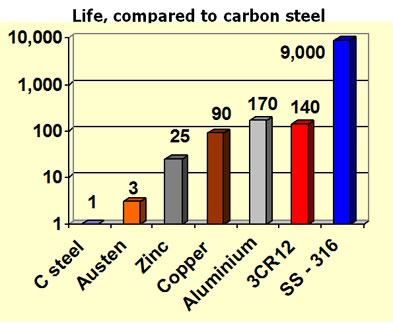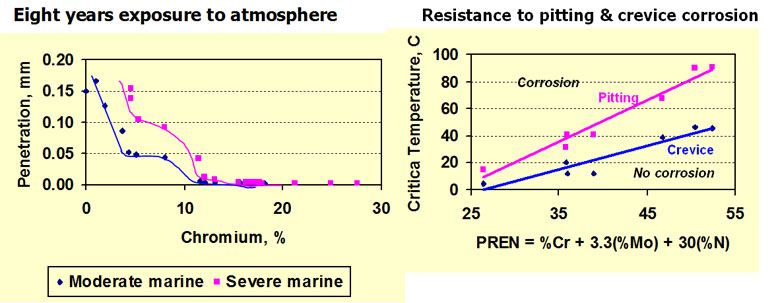“Stainless Steel Doesn’t Rust”Does stainless steel rust? Strictly speaking, stainless steel doesn’t rust. Some industry publications even say it can’t. But like all materials, there are some environments that are just too corrosive and stainless steel will be attacked – after all, even gold will dissolve in aqua regia, a potent mixture of nitric and hydrochloric acids. And sometimes, when stainless steel is attacked, the corrosion product looks just like the rust you get on carbon steel. Stainless steel resists corrosion better than most other metals because of a very thin, colourless passive layer that forms spontaneously on the surface. When the passive layer is breached, it usually forms again spontaneously. In aggressive environments, such as very close to the beach, where there is a lot salt in the air, the passive layer may not be able to form, and some corrosion may take place. Although the stainless steel may look ‘rusty’, which leads people to think that stainless steel rust can occur, but actually, it will corrode so much more slowly than most other metals that it will still be serviceable long after any other common engineering metal. The graph below shows the results of a 20-year corrosion study from a very corrosive environment near a beach in South Africa: an even more severe environment than the most aggressive in Australia, such as Newcastle Beach. Stainless steel grade 316 gave about 9,000 times the life of carbon steel. Grade 304 would be similar, although not quite as much. And this in an environment where each millimetre of carbon steel would corrode away completely in about four years. Of course, the passive layer that stainless steel relies on for protection has to be allowed to form. Blue and black visible oxides formed during heat treating, welding and heavy grinding interfere with the formation of the passive layer. They must be removed to get the full corrosion resistance of each grade of stainless steel. Often, when stainless steel appears to be rusting, it has actually been contaminated with carbon steel – which rusts, of course! And the stainless steel gets the blame. The secret is to fabricate the stainless steel in a dedicated area and make sure there is no contamination with carbon steel from tools, equipment and storage fixtures. And if there is carbon steel contamination, treat the stainless with a passivating acid to remove it.  “All Stainless Steel is the same”Actually, stainless steels are a family of alloys, which can have a great range of properties, depending on what they are to be used for. Stainless steels are often used for their appearance or corrosion resistance, but they are also used for heat resistance, strength or toughness, and for their magnetic properties. The best grade of stainless steel is chosen to suit the application. The grades fit into branches of the family, called austenitic, ferritic, duplex, martensitic or precipitation hardening, depending on their crystal structure. “Stainless Steel is not Magnetic”Some types of stainless steel, including the most common ones, the austenitics, aren’t magnetic. But most types – the ferritics, martensitics, duplexes and most of the precipitation hardening grades – are magnetic. The corrosion resistance is not affected in any way by whether the grade of stainless steel is magnetic or not – corrosion resistance depends on how much of the key alloying elements you have, especially chromium and molybdenum. Even the austenitics can become somewhat magnetic when they are deformed. Try putting a magnet in the corner of a stainless steel sink – some magnetism can usually be detected. The amazing ability of austenitic stainless steel to deform without breaking is used to deep draw sinks in one piece – without heating! “Stainless Steel is Expensive”Stainless steel do cost more than carbon steels, in dollars per tonne. With the extra alloys, they are bound to. But the extra performance of stainless steels more than pays for the difference, and stainless steel often works out as the cheapest way to do the job. Carbon steels usually need to be painted for corrosion protection, and even if their first installed cost is lowest, their advantage disappears on the day they have to be repainted. The cost of stainless in dollars per day for the life of the job will be much lower. “18/10 Stainless Steel is better than 18/8 Stainless Steel”Actually they are both the same. The common austenitic grades contain about 18 to 20% of chromium, and 8 to 10% of nickel. Europeans often refer to them as 18/10 stainless, while the English speaking world – Australia, USA, UK – call them 18/8 stainless steel. There are minor differences between the standard stainless steel compositions in different parts of the world, but the performance of the grades are effectively the same wherever in the world they are made. “All Stainless Steels have the same Corrosion Resistance”The corrosion resistance of stainless steels mostly depends on their content of the alloying elements chromium and molybdenum, plus a few other factors, depending on the specific application. The surface finish and fabrication practice can have a major effect.
|


